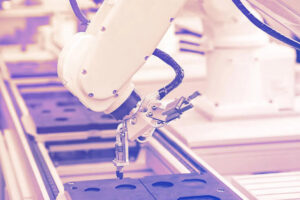 Ever since Newcomen’s first steam pump fired up in 1712, the value of automation of most business processes has been clear. From that time onward, effort-saving automation has progressed through a variety of technological advances. They include the steam engine, the mechanical reaper, the assembly line, and in the 21st century, those machines’ digital equivalents. Robotic Process Automation (RPA) is one of the latest in this series of advancements and it can help your business to operate more efficiently while allowing your human employees to focus on tasks requiring creativity and emotional judgment. Let’s take a closer look at RPA in the business context.
Ever since Newcomen’s first steam pump fired up in 1712, the value of automation of most business processes has been clear. From that time onward, effort-saving automation has progressed through a variety of technological advances. They include the steam engine, the mechanical reaper, the assembly line, and in the 21st century, those machines’ digital equivalents. Robotic Process Automation (RPA) is one of the latest in this series of advancements and it can help your business to operate more efficiently while allowing your human employees to focus on tasks requiring creativity and emotional judgment. Let’s take a closer look at RPA in the business context.
What Is Robotic Process Automation?
Basically, RPA is software that leverages “digital robots” or “bots” able to automate certain human actions. An important element of this idea is to streamline the process of instructing these digital robots using scripts. The tasks the robots complete once created are generally simple, monotonous, and/or repetitive: screen reading, data entry, data analysis for trends, and fielding simple customer service inquiries. People can do a great job at these tasks, but they have bodies that need stretching and hunger that needs feeding during a lunch break. While these are necessary accommodations for human workers, they do put a dent in productivity. Furthermore, automating simple or repetitive tasks allows human employees to do the things that require more complex thinking.
Benefits of Robotic Process Automation
Aside from more consistent productivity, which is significant, there are many facets to the structures that enable the robots to deliver benefits. For example, the higher accuracy of robots doing repetitive tasks is crucial. This is especially true in the banking sector and other sectors where mistakes could be anything from severely annoying to catastrophic.
Another advantage is a combination of resilience and stamina. The most expert, dynamic, motivated, and accurate human being still needs food and sleep. People like that also have families that need attention and employees deserve work-life balance. There is a limit to human endurance at any job, and when it comes to uninteresting, repetitive tasks, that limit is often at odds with what still needs to be done. A digital robot doesn’t need to sleep, eat, or spend time with spouses and children. In theory, it can work 24/7 as long as it has power.
Furthermore, RPA taking over monotonous tasks may encourage your human employees to interact with each other and with customers more often. In other words, having digital robots do the basic things lets the human beings interact with other human beings, and that can provide a better customer experience, as well as a more congenial work environment.
Digital robots are also versatile. Even the most expert human being would find it difficult to be an expert in 10 different things. Properly programmed, a digital robot can be an instant “expert” in a great many fields, assuming that it operates under the guidance of human experts in these fields as well. Human judgment will always be required for the oversight of RPA and of AI in general. However, AI can draw from a wider database of knowledge than any individual human can. An employee whose less creative work tasks are now handled by the bot will not only have more time for more creative tasks, but can also serve as the bot’s programmer and manager. People responsible for administering digital robots can also access them from outside the office, making it more possible for an organizations’ employees can work remotely, contributing to both robot versatility and employee satisfaction.
Part of that versatility also means that digital robots could work with commercial secrets and other sensitive data with much greater security than human beings could. However, this also brings us to the first possible disadvantage with RPA.
Disadvantages of Robotic Process Automation
Even when human interaction with the data is limited, the data are still vulnerable to cyberattack. RPA systems need to have robust security protocols to remain safe. At least one independent agency of the United States government has made recommendations for security precautions around the use of RPA. Companies and other entities that rely on RPA must take all relevant precautions to protect their data.
In their most basic form, RPA bots are very good at doing what you tell them to do, doing each programmed step automatically. They do not learn if they are not given machine learning capabilities, and are not creative either. If they are not integrated with AI, they’ll offer no solutions to complex problems. They also won’t offer feedback on potential problems. They can’t perform duties that require judgment because they cannot think (which is still true of AI, but AI’s more advanced capabilities allow it perform calculations beyond simply executing preprogrammed steps).
As with AI, with RPA there is also a fear among employees that, “I’ll lose my job to this robot,” which may have some basis in fact as certain work tasks can be overtaken by RPA. However, it is important to remember that humans must always supervise RPA’s actions, so it cannot fully replace a human workforce.
Businesses will have to prepare well beforehand to implement RPA. That means creating training and retraining programs, focusing on process improvement. This may also involve preparing the workforce for job reassignment and new responsibilities, avoiding “replacing” employees as much as possible to maintain the morale of the employees that will remain.
Is RPA Right for Your Business?
RPA has been a major part of technological progress and has held significant business potential since its inception. Over that time, there have been numerous improvements to both the digital robots themselves, and the policies and procedures that companies implement as they roll out RPA. Over that time, businesses have gotten better at handling the complexities involved. They’ve also realized that human beings are still necessary, because digital robots cannot do tasks that require judgment or creativity, and even the AI of today does not have truly independent judgment or full creativity. Still, the benefits of such digital robots are great enough that no company or government entity can survive in the business world without considering them.
If you’re ready to start using RPA in your organization, Square Peg Technologies can help. We make sure that when you undertake a technology initiative, your goals remain at the center and the technology facilitates those goals.















